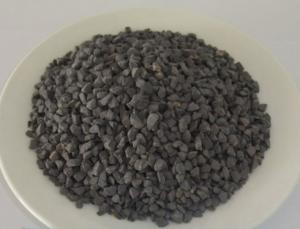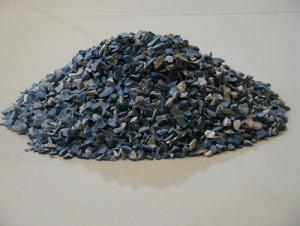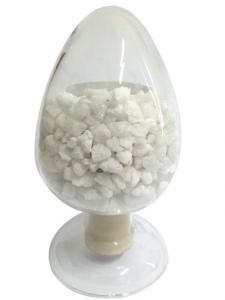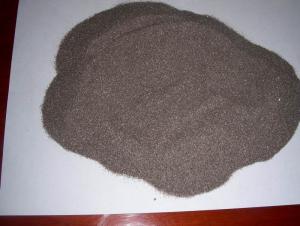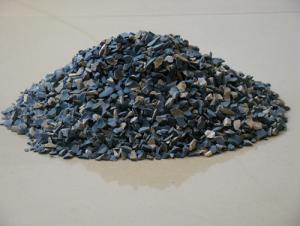Black silicon carbide High purity SiC Supplied by CNBM
- Loading Port:
- China main port
- Payment Terms:
- TT OR LC
- Min Order Qty:
- 25 m.t.
- Supply Capability:
- 2000 m.t./month
OKorder Service Pledge
OKorder Financial Service
You Might Also Like
Specifications
F220 High purity SiC
Professional manufacturer
Passed REACH ,ISO-9001:2008
We provide the best quality C in china with high tech testing instrument gurantee the quality.
Grinding Black Silicon Carbide
Black silicon carbide is produced at high temperature in an electric resistance type furnace with quarts sand and petroleum coke as its main raw materials. It is used for making bonded and coated abrasive tools, grinding metal and non-metal materials of lower tensile strength, such as gray cast iron yellow bronze,aluminum, stone, leather, rubber, etc.
Chemical Compsition (%)
Grit | Sic | F.C. | Fe2O3 |
F12-F90 | ≥98.50 | <0.20 | ≤0.60 |
F100-F150 | ≥98.00 | <0.30 | ≤0.80 |
F180-F220 | ≥97.00 | <0.30 | ≤1.20 |
F230-F400 | ≥96.00 | <0.40 | ≤1.20 |
F500-F800 | ≥95.00 | <0.40 | ≤1.20 |
F1000-F1200 | ≥93.00 | <0.50 | ≤1.20 |
P12-P90 | ≥98.50 | <0.20 | ≤0.60 |
P100-P150 | ≥98.00 | <0.30 | ≤0.80 |
P180-P220 | ≥97.00 | <0.30 | ≤1.20 |
P230-P500 | ≥96.00 | <0.40 | ≤1.20 |
P600-P1500 | ≥95.00 | <0.40 | ≤1.20 |
P2000-P2500 | ≥93.00 | <0.50 | ≤1.20 |
Physical Index
Grits | Bulk Density | High Density | Grits | Bulk Density | High Density |
F16 ~ F24 | 1.42~1.50 | ≥1.50 | F100 | 1.36~1.45 | ≥1.45 |
F30 ~ F40 | 1.42~1.50 | ≥1.50 | F120 | 1.34~1.43 | ≥1.43 |
F46 ~ F54 | 1.43~1.51 | ≥1.51 | F150 | 1.32~1.41 | ≥1.41 |
F60 ~ F70 | 1.40~1.48 | ≥1.48 | F180 | 1.31~1.40 | ≥1.40 |
F80 | 1.38~1.46 | ≥1.46 | F220 | 1.31~1.40 | ≥1.40 |
F90 | 1.38~1.45 | ≥1.45 |
Size Available
F12-F1200,P12-P2500
0-1mm,1-3mm,6/10, 10/18, ,200mesh,325mesh
Other special spec. could be supplied as required.
Applications
Grinding non-ferrous materials, rock, stone, leather, rubber, finishing tough and hard materials.
Bonded Abrasive tools, lapping and poishing.
Widely used as a metallurgical additive and refractory material.
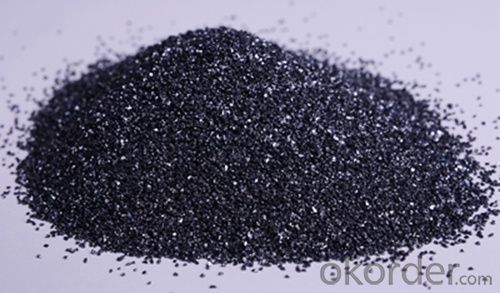
- Q:Can anyone tell me the requirements of the refractory masonry??
- Kaolin is mainly composed of kaolinite crowded minerals that is in the shpe of tiny flake which is less than two microns, tube and folding flake. The kaolinite crowded mineral consists of kaolinite, dickite, pearl stone, halloysite, etc. and its ideal chemical formula is AL2O3-2SiO2-2H2O. The main mineral component of it is kaolinite and halloysite.In addition to the kaolinite crowded mineral, kaolin is accompanied by other minerals like montmorillonite, illite, pyrophyllite, quartz and feldspar. The chemical composition of kaolin contains large amounts of AL2O3, SiO2, and a small amount of Fe2O3, TiO2, and traces of K2O, Na2O, CaO and MgO, etc. The white pottery is made of kaolin. At present, the internationally accepted scientific name for kaolin is Kaolin which is derived from the kaolin mountain in the eastern suburb of kaolin village in Jingdezhen.Such special properties of kaolin as its plasticity,cohesiveness, certain dry strength, sinterability and firing whiteness make it the main raw material for ceramic production; properties like whiteness, softness, high dispersibility, and adsorbability allows it to be widely used the paper industry. In addition, the kaolin is also widely used in some industrial sectors such as rubber, plastics, refractories, oil refining as well as agriculture sector and cutting-edge technology for national defense. According to the purpose and requirements, kaolin can be processed and purified and it can be used to manufacture activated clay.
- Q:What is the common inorganic fireproof and thermal inuslation matertial?
- inorganic materials of insulation materials 1, inorganic thermal insulation materials are mainly concentrated in the materials that have a certain insulation effect and can achieve level A fireproofing, such as aerogel blanket, glass wool, rock wool, expanded perlite and micro-nano thermal baffle. 2, rock wool production is harmful to human body, workers also do not want to occure the situation under the construction. The cycle of rock wool construction plate is long about 2 years from construction to production. The supply of the domestic wool market also cannot meet the requirements for use. 3, expanded perlite has great weight and high water absorption. 4, the insulation performance of micro-nano insulation panels is 3-5 times that of conventional insulation materials, commonly used in high temperature environment, but is more expensive. 5, aerogel blanket is level A1 inorganic fireproofing building materials, thermal conductivity at room temperature is 0.018W / (K · m), and absolutely waterproofing, its insulation performance is 3-8 times of traditional materials, which can replace the unenvironment-friendly froconventional flexible material with poor insulation properties, such as glass fiber products, asbestos insulation felt and silicate products.
- Q:What refractories can withstand high temperature above 2100 degrees?
- You can refer to advices from the first one coupled with the second one.
- Q:how to divided the external wall thermal insulation materials fire rating
- Level A: Incombustible building material: It is a kind of material that almost does not occur burning. Level B1: Nonflammable building material: Non-flame material has good flame resistance. It is difficult to fire under the condition of open fire in the air or high temperature, and it is not easy to quickly spread, and when the combustion?source is removed, the combustion will stop immediately. Level B2: Combustible?building?materials: Flame material has a good flame resistance. In case of fire in the air or at high temperature, it will immediately burst into flames, and easily lead to the spread of fire, such as wooden column, timber roof truss, timber beam and wooden stairs. Level B3: Combustible?building?materials: It has no any flame resisting effects, and is easy to burn, so the fire risk is high.
- Q:Urgently!! Refractory problems, online, etc.
- Uneven contraction. When the magnesia block wall is made, the steel wire mesh can be added to the magnesium block wall. That will solve the problem.
- Q:what's the requirements of refractory for forge furnace?
- accurate answers please refer to Current Situation and Development Trend of Refractory Material in Heating Furnace ,Quality Requirement of Modern Industrial Furnace Refractory Material(GB/T17638-1998) Standard,Furnace-constructing Technology, if you need the mail box, please senf e-mail to me, my QQ number: 249704548.
- Q:How to choose the material of refractory?
- Long using temperature of aluminum oxide fiber is 1400 ℃, containing chromium aluminum silicate fiber, quartz, high purity aluminum silicate fiber, long-term use of temperature is 1000-1200 ℃ has aluminum silicate refractory fiber according to different raw materials, advanced refractory fiber (such as alumina. Commonly used vitreous aluminum silicate refractory fibre is amorphous, zirconium oxide refractory fibre) using temperature is 1700 ℃ view as >and the best temperature is 1300 ℃. Crystalline refractory fiber are polycrystalline mullite fiber, including ordinary aluminum silicate fiber, alumina and graphite refractory fiber, etc. The use of common refractory fiber temperature is 1150 ℃;>
- Q:What is the acceptance standard of refractory?
- It depends on the variety of materials. In general the main test items include chemical composition, refractoriness, refractoriness under load, creep, volume density, linear change, strength, slag resistance, thermal conductivity and thermal expansion. If it is shaped products, it is required to inspect the size deviation and whether it has edge. Detection method accords with the relevant national standards and there are lots of them. You can refer to the standard compilation.
- Q:What kinds of refractory will be used in kiln of sintering ceramics?
- If it is ordinary ceramic, you can use ordinary clay bricks and high alumina brick, adding calcium silicate board, the insulating brick and cotton fiber.
- Q:What are unshaped fire-resisitance materials?
- Refractory castable, refractory plastic material, usually classified according to construction and manufacture method, unfired bricks precast block, refractory pressed into material, refractory cast material, refractory coating, refractory ramming material there are many classification methods
1. Manufacturer Overview |
|
|---|---|
| Location | |
| Year Established | |
| Annual Output Value | |
| Main Markets | |
| Company Certifications | |
2. Manufacturer Certificates |
|
|---|---|
| a) Certification Name | |
| Range | |
| Reference | |
| Validity Period | |
3. Manufacturer Capability |
|
|---|---|
| a)Trade Capacity | |
| Nearest Port | |
| Export Percentage | |
| No.of Employees in Trade Department | |
| Language Spoken: | |
| b)Factory Information | |
| Factory Size: | |
| No. of Production Lines | |
| Contract Manufacturing | |
| Product Price Range | |
Send your message to us
Black silicon carbide High purity SiC Supplied by CNBM
- Loading Port:
- China main port
- Payment Terms:
- TT OR LC
- Min Order Qty:
- 25 m.t.
- Supply Capability:
- 2000 m.t./month
OKorder Service Pledge
OKorder Financial Service
Similar products
New products
Hot products
Related keywords






















